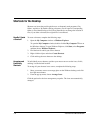
4-2 Connecting To The World
Using Your
Modem with the
56K ITU V.90
Standard
If DSL service is not yet available in your area, your modem is ready to operate using
the 56K ITU V.90 Standard. You will be able to download files at a rate of up to 56
Kbps over standard telephone lines.
The 56K ITU V.90 Standard enables text, sound, and video files to race to your
computer. The download rate is faster than the upload rate. The maximum download
speed is up to 56 Kbps and the maximum upload speed is up to 33.6 Kbps.
Transmission rates may vary depending on telephone line conditions.
+
NOTE:
Although your modem is capable of download speeds of up to 56 Kbps, current
FCC regulations limit download speed to 53 Kbps.
Establishing an
Account with an
Internet Service
Provider
Before you can connect to an ISP using your modem, you must establish an ISP
account. Internet connection service using the 56K ITU V.90 Standard is widely
available. Contact an ISP for information on establishing an ISP account. Refer to the
Getting Started Guide for more information.
DSL Benefits
DSL service makes it possible to download large files in seconds rather than hours
using low-cost high-speed broadband data transfer technology over standard
telephone lines.
+
NOTE:
To determine if DSL service is available in your area, contact your
telecommunications service provider and your ISP. If compatible DSL service is
available, you must subscribe to that service.
Additional DSL benefits include the following:
◆ Talk and surf at the same time. You can simultaneously talk on the phone,
surf the Web, and download files using a single telephone line.
◆ Increased download transfer rate. Using the Digital DSL/56K Modem, you
can download files approximately 100 times faster than with a 56K ITU
V.90-compliant modem.
◆ Increased upload transfer rate. Using the Digital DSL/56K Modem,
you can upload files at a significantly faster rate than with a 56K ITU
V.90-compliant modem.
+
NOTE:
To achieve the significant data transfer speeds associated with DSL service,
your telecommunications service provider and ISP must provide the type of DSL
service that is compatible with your modem.


















